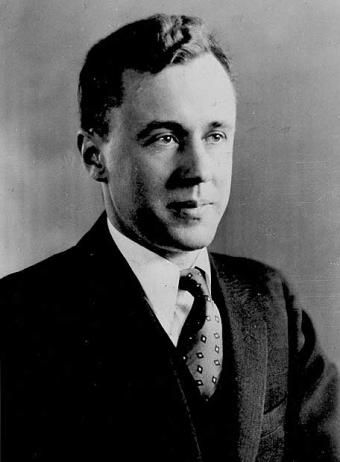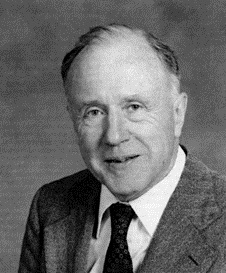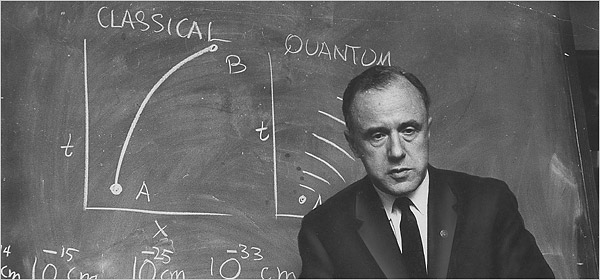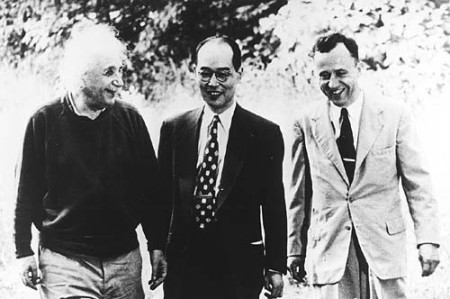<Back to Index>
- Physicist John Archibald Wheeler, 1911
- Conductor and Composer Richard Hageman, 1881
- Duca di Parma e Piacenza Roberto I Carlo Luigi Maria di Borbone, 1848
PAGE SPONSOR



John Archibald Wheeler (July 9, 1911 – April 13, 2008) was an American theoretical physicist who was largely responsible for reviving interest in general relativity in the United States after World War II. Wheeler also worked with Niels Bohr in explaining the basic principles behind nuclear fission. One of the later collaborators of Albert Einstein, he tried to achieve Einstein's vision of a unified field theory. He is also known for having coined the terms black hole, quantum foam and wormhole and the phrase "it from bit". For most of his career, Wheeler was a professor at Princeton University and was influential in mentoring a generation of physicists who made notable contributions to quantum mechanics and gravitation.
John Archibald Wheeler was born in Jacksonville, Florida. He graduated from the Baltimore City College high school in 1926 and earned his doctorate from Johns Hopkins University in 1933. His dissertation research work, carried out under the supervision of Karl Herzfeld, was on the theory of the dispersion and absorption of helium.
Wheeler started his academic career at the University of North Carolina at Chapel Hill in 1935 and in 1938 moved to Princeton University where he remained until 1976. He then became the director of the Center for Theoretical Physics at the University of Texas from 1976 to 1986, when he retired from academic work. At the time of his death, Wheeler had returned to Princeton University as a professor emeritus. Professor Wheeler's graduate students included Richard Feynman, Kip Thorne, Jacob Bekenstein and Hugh Everett. Unlike some scholars, Wheeler gave a high priority to teaching. Even after he became a famous physicist, he continued to teach freshman and sophomore physics, saying that the young minds were the most important. Wheeler supervised more PhD as well as senior undergraduate theses than any other professor in the Princeton physics department.
Wheeler made important contributions to theoretical physics. In 1937, he introduced the S-matrix, which became an indispensable tool in particle physics. Wheeler was a pioneer in the theory of nuclear fission, along with Niels Bohr and Enrico Fermi. In 1939, Wheeler collaborated with Bohr on the liquid drop model of nuclear fission.
Together with many other leading physicists, during World War II, Wheeler interrupted his academic career to participate in the development of the atomic bomb during the Manhattan Project, working at the Hanford Site in Washington, where several large nuclear reactors were constructed to produce the element plutonium for atomic bombs. Even before the Hanford Site started up the "B-Pile" (the first of its three reactors), Wheeler had anticipated that the accumulation of "fission product poisons" would eventually impede the ongoing nuclear chain reaction by absorbing many of the thermal neutrons that were needed to continue a chain reaction. Wheeler deduced that an isotope of the noble gas xenon (Xe135), by calculating its half - life in radioactive decay, would be one most responsible.
Some years later, Wheeler went on to work on the development of the more powerful hydrogen bomb under the Project Matterhorn nuclear weapons program.
After concluding his Manhattan Project work, Wheeler returned to Princeton University to resume his academic career. In 1957, while working on mathematical extensions to the Theory of General Relativity, Wheeler introduced the concept and the word wormhole to describe hypothetical "tunnels" in space - time.
During the 1950s, Wheeler formulated geometrodynamics, a program of physical and ontological reduction of every physical phenomenon, such as gravitation and electromagnetism, to the geometrical properties of a curved space - time. Aiming at a systematical identification of matter with space, geometrodynamics was often characterized as a continuation of the philosophy of nature as conceived by Descartes and Spinoza. Wheeler's geometrodynamics, however, failed to explain some important physical phenomena, such as the existence of fermions (electrons, muons, etc.) or that of gravitational singularities. Wheeler therefore abandoned his theory as somewhat fruitless during the early 1970s.
For a few decades, general relativity had
not been considered a very respectable field of physics, being detached
from experiment. Wheeler was a key figure in the revival of the
subject, leading the school at Princeton, while Sciama and Zel'dovich developed the subject at Cambridge University and the University of Moscow. The work of Wheeler and his students made high contributions to the Golden Age of General Relativity. His work in general relativity included the theory of gravitational collapse. The term black hole was coined in 1967 during a talk he gave at the NASA Goddard Institute of Space Studies (GISS). He was also a pioneer in the field of quantum gravity with his development (with Bryce DeWitt) of theWheeler - DeWitt equation or, as he called it, the "wave function of the Universe." Recognizing Wheeler's colorful way with words, characterized by such confections as "mass without mass", the festschrift honoring his 60th birthday was fittingly entitled Magic Without Magic: John Archibald Wheeler: A collection of essays in honor of his sixtieth birthday, Ed: John R. Klauder. Wheeler was the driving force behind the voluminous general relativity textbook Gravitation, co-written with Charles W. Misner and Kip Thorne.
Its timely appearance during the golden age of general relativity and
its comprehensiveness made it the most influential relativity textbook
for a generation. In 1979, Wheeler spoke to the American Association for the Advancement of Science (AAAS), asking it to expel parapsychology, which had been admitted ten years earlier at the request of Margaret Mead. He called it a pseudoscience, saying
he didn't oppose earnest research into the questions, but he thought
the "air of legitimacy" of being an AAAS Affiliate should be reserved
until convincing tests of at least a few so-called psi effects could be
demonstrated. His request was turned down, and the Parapsychological Association remained a member of the AAAS. In
1990, Wheeler has suggested that information is fundamental to the
physics of the universe. According to this 'it from bit' doctrine, all
things physical are information - theoretic in origin. Wheeler was awarded the Wolf Prize in Physics in 1997. Wheeler
has speculated that reality is created by observers in the universe.
"How does something arise from nothing?", he asks about the existence
of space and time. He also coined the term "Participatory Anthropic Principle" (PAP), a version of a Strong Anthropic Principle. From a transcript of a radio interview on "The anthropic universe": On April 13, 2008, Wheeler died of pneumonia at the age of 96 in Hightstown, New Jersey. In April 2009, Wheeler was the focus of the monthly periodical Physics Today published by the American Institute of Physics. The articles contained reflection by prominent physicists, including many of those for whom he served as an academic advisor.
Martin Redfern: Many
don't agree with John Wheeler, but if he's right then we and presumably
other conscious observers throughout the universe, are the creators —
or at least the minds that make the universe manifest.
